Study of the Toxicity of Cadmium Selenide (CdSe) on a Model Bio Indicator Helix aspersa
Aya Salmi *, Rachid Rouabhi
Department of Applied Biology, University Larbi Tbessi, Tebessa, Algeria
*Corresponding author: Aya Salmi, Department of Applied Biology, University Larbi Tbessi, Algeria. Tel: +213213774516583; Email: ayasalmi13@yahoo.fr
Received Date: 18 June, 2018; Accepted Date: 03 August, 2018; Published Date: 14 August, 2018
Citation: Aya S, Rachid R (2018) Study of the Toxicity of Cadmium Selenide (CdSe) on a Model Bio Indicator Helix aspersa. Arch Environ Sci Environ Toxicol: AESET-102 DOI: 10.29011/AESET-102.10000
- Abstract
The Nano Particles (NP) metal playing an increasingly important both in industrial processes and in biomedical research. However, data on potential toxicity to living organisms remains insufficient.
The aim of this work was to study the effects of semiconductor nanomaterials (CdSe) on a bio indicator species in ecotoxicology, the land snail Helix aspersa. The snails were injected with increasing concentrations CdSe for 03 months. We sought to evaluate the effects of oxidative stress on the digestive gland and by monitoring the activity of certain enzyme biomarkers: GST and catalase. We also measured the levels of reduced glutathione and total protein. Malondialdehyde (MDA) considered as a biomarker of lipid peroxidation was also measured.
Thus, the neurotoxicity of CdSe was confirmed through the measurement of Acetylcholinesterase (AChE). Our results show an increase in the activity of antioxidant enzymes (GST, catalase, MDA) and decreased GSH levels in the digestive gland, as we have also identified a neurotoxic effect CdSe results in reduced activity Acetylcholine Esterase (AChE).
- Keywords: CdSe; Helix aspersa; Oxidative Stress; Toxicity
3.Introduction
The late twentieth and early twenty-first centuries saw the emergence of a new kind of materials: nanoparticle, that is to say a particle size of less than 100 nm. We will not discuss in this study nanoparticles of natural origin, from volcanoes or fires, which have existed for millennia, but manufactured nanoparticles intentionally by humans [1].
Thanks to their special properties due to their small size, nanomaterials are used in numerous consumer applications (cosmetics, nanostructured materials, ...). However, the increasing use of such materials today raises public health issues. Indeed, the interaction of nanoparticles with biological systems and their potential toxicity, are the little-known today. The associated health risk is therefore difficult to evaluate [2].
The snails have been widely used as a model system to reveal biomarkers of environmental pollution, the central model of this study is the small gray snail Helix aspersa, known for its important to be bio accumulative in its tissues.
The objective of this work is to study the toxicological effects induced by manufactured nanoparticles (CdSe) on an organism bioaccumulation, land snail Helix aspersa.
- Material and Method
-
- Biological Material
Description Helix aspersa [3]. Helix aspersa, better known under the name snail gardens or Little gray and used in our experiments is a gastropod mollusk pulmonate stylomatophore belonging to the family of Helicidae.
-
- Breeding Snails
Sampling of the snail Helix aspersa was performed at Beccaria in the wilaya of Tebessa Raising Snails Helix aspersa at the cellular toxicology laboratory during the period 3 months.
Snails are raised in the following conditions that are considered optimum: photoperiod of 18 h light / 24 h, temperature 20 ± 2°C, humidity of 80 to 95%; feeding the wheat flour. Snails are distributed in transparent plastic boxes with perforated lid. Each box contains a wet sponge to retain moisture [4,5].
-
- Chemical Equipment
-
-
- Definition
-
The semiconductor nanocrystals (CdSe) are objects of size between 1 and 100nm and formed of a few tens of thousands of atoms arranged in a crystalline order. They are made by chemical synthesis by mixing in solution the elements (e.g., carbon cadmium and selenium) that make up the semi-conductive material. At temperatures of some hundred degrees, the different elements fit together to start the nucleation and growth of the material.
-
-
- Synthesis of Nanoparticles CdSe
-
There are several methods to get nanoparticles CdSe. The synthesis of CdSe nanocrystals was made by standard chemical techniques to air. A mixture of CdO (1.8 mmol, 0.2311 g), oleic acid (OA, 6.0 mmol) and diphenyl ether (8 ml) was heated to 18°C for 2 hours. Then a solution of 3.2 g of selenium TOP, which contains 0.32 g, 4.0 mmol of selenium was injected very rapidly in this hot solution [6].
-
- Procedure
Treatment of animals was performed by injecting skin with a micro syringe We selected two doses and a control medium. The doses that have been used are 3.6µg/g/2j (Jackson et al. 2012) and 7.2µg/g/2j.
- Preparation and sacrifice of animals After the treatment period, the snails are placed fasting for 48 hours to empty their digestive tract, the animals are then sacrificed by freezing at -20°C and then dissected,
- The extraction and protein quantification: The proteins are quantified by the method of Bradford (1976) [7].
- The catalase activity: The catalase activity was determined in the hepatopancreas calorimetrically according to [8]. H2O2 disappearance rate is monitored by observing the rate of decrease in absorbance at 240 nm.
- The activity of GST: The measurement of the activity of Glutathione S-Transferase (GST) is determined according to the method of Habit et al. [9] following the formation of 1-glutathione-2,4-dinitrobenzene resulting from the conjugation between the substrate (1-Chloro-2,4-Di Nitro Benzene (CDNB) with reduced glutathione [9].
- The GSH: Glutathione level is determined according to the method of Weckbeker and Cory [10].
- The MDA levels: The assay of MDA is carried out according to the method of Ester Bauer. MDA may be detected by a colorimetric reaction with Thio Barbituric Acid (TBA).
- The AChE activity: The assay of AChE activity was conducted according to the method of which comprises providing the enzyme (AChE) an analogue artificial substrate, acetylthiocholine, which will be hydrolyzed to acetic acid and thiocholine.
The latter in the presence of DTNB (5'-dithio-bis-2-nitrobenzoic acid) yields a yellow product TNB (acid 5-thio-2-nitrobenzoic acid) which is determined at a wave length of 412 nm [11].
- Results
The results are expressed as mean ± (standard deviation) of n experiments (where n represents the number of animals used with n = 10), differences are considered: significant when p ≤ 0.05, very highly significant when P ≤ 0001, highly significant when P ≤0,01.
- Discussion
The purpose of this study is to understand how organisms like snails adapt to toxicity against cadmium selenide. The production of reactive oxygen species is considered as a key factor of the adaptive response or reaction to a toxic event, it is whether the latter is characterized by an increase in antioxidant defenses [13].
Current knowledge of the toxic effects of nanoparticles are relatively limited. Available data indicate that some insoluble nanoparticles can cross different protective barriers, is distributed in the body and accumulate in various organs. Toxic effects have been documented at the pulmonary, cardiac, reproductive, renal, skin cell and as nanoparticles can be distributed throughout the body, including inside the cells. Significant accumulations were demonstrated in the lungs, brain, liver, spleen and bone [12].
The toxicity of certain quantum wells may be related to the release of cytotoxic ions to oxidative mechanisms (14). .and other phenomena less well understood [15].
The total protein content is a test often used to highlight a stress in a bio-indicator organism [16]. Indeed, when environmental stresses (drought stress, thermal, oxidative, exposure to pollution, infection by pathogens ...) are strong, most proteins undergo denaturation [17].
In our work, we have demonstrated a significant increase in protein levels at the hepatopancreas, these results point in the same direction as those of Grana., [18] which highlight also increased protein levels total at hepatopancreas snails treated with heavy metals. On the other hand, Koehler, et al. [19] suggest early induction of the synthesis of the storage structures (MTs and granules) bonded to toxic kinetics after exposure of the slug D. reticulum at high concentrations of Cd, Pb and Zn simultaneously with the induction of stress proteins HSP 70. Our results support this work, as we have also shown an increase in the protein levels in the presence of cadmium nanoparticle.
The exposure of snails CdSe resulted in a very highly significant increased activity of catalase (CAT) in the hepatopancreas, this increase is dose-dependent on the concentration of CdSe. Exposure Experiments with TiO2 NP in the terrestrial invertebrate Poercellio saber revealed sub lethal effects such as induction of catalase [20]. Our results are in perfect agreement with those of Buffet et al. [21] who observed induction of CAT in the bivalve Spline and annelid Divers H color exposed to Cu NPs. The CAT also induced in Spline exposed to AT NP [22,23] also observed an induction of CAT in magna D exposed to TiO2 NP.
S. PAIN-DEVIN, et al. a studied the effect of three nanoparticles (nAg, nTiO2, nCeO2) on two models of aquatic invertebrates (Dreissena polymorph and Grammars spa), they reduced exposure concentrations of 1000 mg / L (nTiO2) 0.5 mcg / L (nAg) and increased exposure time of 24 to 21 days (nCeO2). A large battery of biomarkers was used to evaluate the impacts of exposure, such as lysosomal and antioxidant defenses (catalase, GPx, MDA). they showed some effects on some parameters evaluated, such as an increase in antioxidant activity, their results are struggling to clearly demonstrate the harmful effect of nanoparticles at lower concentrations.
Our results have shown, very highly significant levels of MDA in the digestive gland in Helix aspersa treated with cadmium selenide. These results are consistent with those of Dutta, et al. [24] have shown that elevated levels of Malondialdehyde, a byproduct of lipid peroxidation, correlated to the production of ROS by the zinc oxide nanoparticles placed under illumination. Moreover, Sewell, et al. [25] showed a significant increase in the rate of MDA in the marine snail Linnaean natalensis exposed to environmental pollutants.
The decrease in the rate of GSH could be explained by a reaction / CdSe direct bond with glutathione, indeed the carboxyl groups of the glutathione (amine group, sulfhydryl group (-GH) as well as two peptides) are combined with the xenobiotic This interaction takes place through the intervention of the GST that allows the conjugation of xenobiotic or its metabolites with GSH in phase II metabolism.
GST is in phase II biotransformation in the conjugation reaction. Our results show a highly significant dose-dependent increase and GST at the digestive gland. Induction of GST was observed in Spline and Divers H Color Cu exposed to NP [26] and Spline to the NP [22] this biomarker was also boosted by galloprovincialis Exposed to SiO2 NP [27] and D. magna exposed to TiO2 NP [23].
The AChE has a role in the transmission of nerve impulses because it hydrolyzed the neurotransmitter acetylcholine. Its inhibition is a biomarker of neurotoxicity. The decrease in its activity is often associated with the presence of organic or metal contaminants in the medium.
In our study we demonstrated a dose-dependent decrease and very highly significant activity of AChE in treated snails, these results are confirmed by the work of Wang, et al. [20] which showed that different types of nanoparticles could pose neurotoxic properties and propose using AChE as a biomarker for NP. Neurotoxic effects evidenced by the inhibition of AChE was demonstrated after only 15 days of exposure to M. galloprovincialis exposed to Cu NP [28]. showed inhibition of cholinesterase activity during exposure of carp Cyprinids carpi juveniles to Cu NP, and also suggest their potential neurotoxic power. In vitro and in vivo studies in mammals, instability or biodegradation of the nanoparticles CdSe leads to the release of toxic metal ions Cd2 + [29]. The specific chemical properties of metals, including their ability to bind to electron donor atoms (O, S, N), or participate in reactions of oxidation-reduction, can lead to deleterious effects on the cell with including the occurrence of oxidative stress, structural alterations or physiological / enzymatic dysfunction. The mechanisms involved in the toxicity of metals have recently been summarized in a review Limier, et al. [30].
- Conclusion
In this study, we investigated the effect of oxidative stress on CdSe biomarkers hepatopancreas of the snail Helix aspersa. We can conclude that the species Helix aspersa is sensitive to the presence of semiconductor materials CdSe, this sensitivity was demonstrated by the effects of oxidative stress induced and enzymatic mechanisms involved.
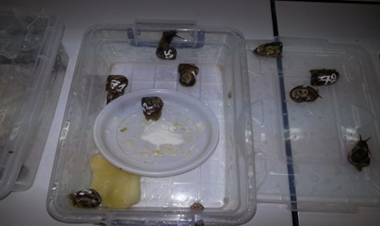
Figure 1: Breeding snails Helix aspersa (staff photo).
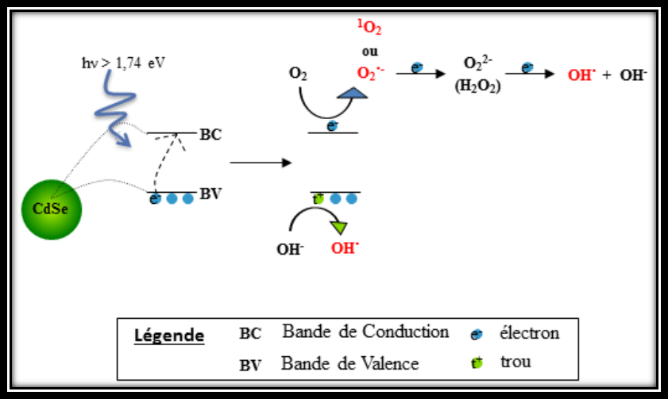
Figure 2: Production of ROS by the CdSe [12].
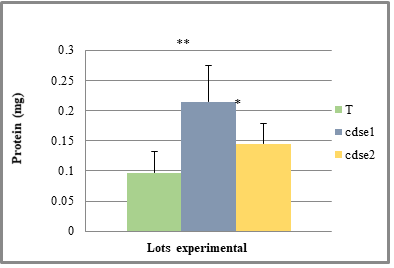
Figure 3: Variation of tissue protein content (mg) in control and treated snails after 90 days of treatment.
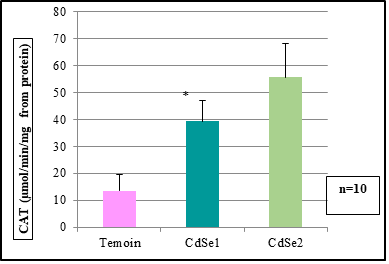
Figure 4: Change catalase activity (nmol / min / mg port) in hepatopancreas in control snails and treated after 90 days of treatment.
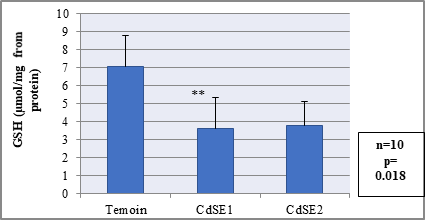
Figure 5: Change of GSH (mol / mg port) in hepatopancreas in control snails and treated after 90 days of treatment.
 \
\
Figure 6: Variation in the activity of GST (µmol / min / mg port) in the hepatopancreas snails in control and treated after 90 days of treatment.

Figure 7: Change in tissue MDA content (nmol / mg port) in the hepatopancreas snails in control and treated after 90 days of treatment.
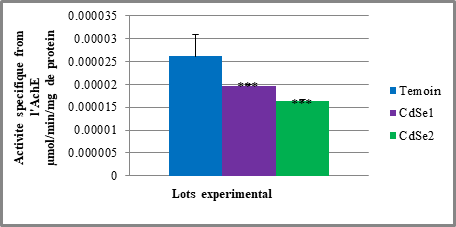
Figure 8: Variation of the activity of AChE hepatopancreas (in nmol / min / mg protein) of the control snails and treated after 90 days of treatment.
- Zeyons O (2008) Studies of physicochemical and biological interactions of manufactured nanoparticles and environmental bacteria. Doctoral thesis of the University Paris VI - Pierre and Marie Curie. La France. P13.
- Triboulet S (2013) The effects of two types of metal nanoparticles in murine macrophages by a proteomic approach. Thesis for the Dr grade University of Grenoble. France. p 25.
- Benedicta Viard - La Rocca (2004) Auto Adjust and Validation of Sites Contamines (Elm-Hap) On Biomonitoring in Test in Microcosm: Growth and Bioaccumulation for the snail Helix aspersa Earth. Doctoral thesis. University De Metz 64.
- Coeurdassier M, Denis M, Gomot Vaufleury de A, Ribera D, Badot PM (2001) The garden snail (Helix aspersa) as bio indicator of organophosphorus exposure: effects of dimethoate is survival, growth and acetylcholinesterase’s activity. Environment Toxicol & Chem 20: 1951-1957.
- Gomot A (1997) Effects of heavy metals on the development of snails. Using snails as bio-indicators of pollution by heavy metals for the preservation of human health. Bull Acad Natal Med 181: 59-75.
- Nguyen DP (2005) University of Paris VI.
- Bradford MM (1976) A rapid and sensitive method for quantitation of microgram quantities of protein Utilizing the principal of protein-dye binding. Analytical Biochemistry 72: 248-254
- Regoli F, Principato G (1995) Glutathione, glutathione-dependent antioxidant enzymes and in mussel Mytilus galloprovincialis exposed to metals under laboratory and field conditions: implication for the biomarkers. Aquatic Toxicology 31: 143-164.
- Habit WH, Pabst MJ, Jakoby WB (1974) The first enzymatic step in mercapturic acid formation. Glutathione S-transferases. Journal of Biological Chemistry 249: 7130-7139.
- Weckbeker G, Cory JG, (1988) Ribonucleotide reductase activity and growth of glutathione-depleted mouse leukemia L 1210 cells in vitro. Cancer Letters 40: 257 264
- Ellman GL, Courtney KD, Andres V, Featherstone RM (1961) A new and rapid colorimetric determination of acetylcholinesterase activity. Biochemistry and Pharmacology 7: 88-90.
- Kauffer FA (2014) Synthesis, stability and toxicity of quantum dots CdSe at heart. Thesis for obtaining the title of Doctor of the University of Lorraine. P 102
- Camille Letellier. antioxidant capacity in helicoids: interspecies and interspecies variations. Master 2 EFCE. UMR 6553, ACS team
- Kirchner C, Liedl T Kundera S, T Pellegrino, Javier Munoz A, Gaub ET Stolzle S, et al. (2005) Cytotoxicity of colloidal CdSe and CdSe / ZnS nanoparticles. Nano Lett 5: 331-338.
- Shiokara A, Hoshino A, Hanaki K, Suzuki K, Yamamoto K (2004) On the cytotoxicity Caused by quantum dots. Microbial Immunol 48: 669-675
- Benbouzib H (2012) Evaluation and study of the toxicity of a matricide family on ciliated protest. Doctoral thesis at the University of Annaba. p 87
- Mohammadkhani N, Haidari R (2008) Water stress induced by polyethylene glycol 6000 and sodium chloride in two corn cultivars. Pak J Biol Sci 11: 92-97
- Grara, N (2011) Evaluation of the toxicity of certain pollutants Industries on animal bio accumulative (gastropod Helix aspersa). Metal Case doctoral. University Annaba.120: 91.
- Köhler HR, Lazzaro R, Dibrenner N, Capowiez Y, Mazzia C, et al. (2009) Snail phenotypic variation and stress proteins: heat do different response strategies contribute to Waddington's widget in field populations?. Journal of Experimental Zoology B Molecular and Developmental Evolution 312: 136-147
- Wang Z, Zhao J, Li F, Gao D, Xing B (2009) Adsorption and inhibition of acetylcholinesterase by different nanoparticles. Chemosphere 77: 67-73
- Zhao J, Wang Z, Lie X, Xie X, Zhang K, et al. (2011) Distribution of CuO nanoparticles in juvenile carp (Cyprinus carpio) and their potential toxicity. J Hazard Mater 15: 304-310
- Pan JF, Buffet PE, Poirier L, Amirad-Triquet C, Gilliland D (2012) Size dependent bioaccumulation and Eco toxicity of gold nanoparticles in an invertebrate: Tellinid the clam Scorbicularia plana. Environmental pollution 168: 37-43.
- Articles in an invertebrate endocentric. Fellini the clam Scorbicularia plana. Environmental pollution. 168: 37-43.
- Dutta RK, Nenavathu BP, Gangishetty MK, Reddy AV (2012) Studies on antibacterial activity of ZnO nanoparticles by ROS induced lipid peroxidation. Colloids and Surfaces Bio interfaces 94: 143-50.
- Siwela AH, Nashi CB, Naik YS (2010) A comparison of metal levels and antioxidant enzymes in freshwater snails, Lymnaea natalensis, exposed to sediment and water from the file Managed Wright Dam and Lower Mkuze Dam, Bulawayo, Zimbabwe. Approximately Ecotoxicology Safe 73: 1728-3172.
- Buffet PE, Tankoua, Pan JE, Burhan D, Herrenknecht C, et al. (2011)
- Canesi L, Fabric Gigolo R, Val lotto D, Marcomanni A, Pajama G (2010) Biomarkers in Mytilus galloprovincialis exposed to suspensions of selected nanoparticles (Nano carbon black, C60 fullerene, Nano TiO2, Nano SiO2). Aquatic Toxicology 100: 168-77.
- Believer and Gory J (1981) A comparative analysis of acute toxicity of chromium, copper and cadmium to Daphnia magna, Biomphalaria glabrata, and Brach danio radio, Environmental Technology Letters 2: 119128
- Gomes T, Pinheiro JP, Cancio I, Pereira CG, Cardoso C (2011) Effects of copper nanoparticles exposure in the Mussel Mytilus galloprovincialis. Environmental science and technology 45: 9356-9362.
- Limier JA, Harrison JJ, Turner RJ (2013) Antimicrobial activity of metals: Mechanisms, molecular targets and applications. Nature Reviews Microbiology 11: 371-384.

 research article
research article